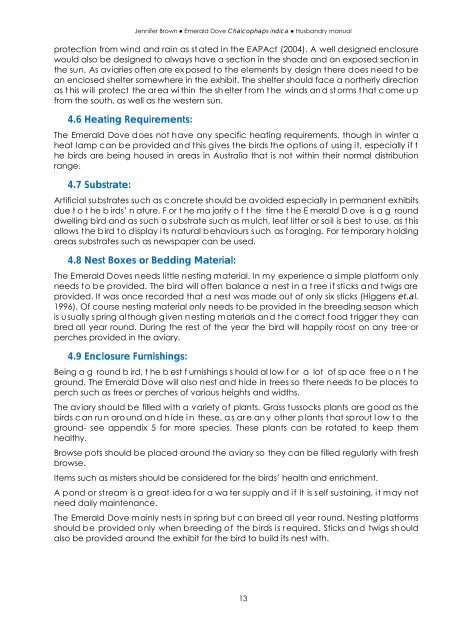Emerald Dove Husbandry Manual - Nswfmpa.org
Emerald Dove Husbandry Manual - Nswfmpa.org
Emerald Dove Husbandry Manual - Nswfmpa.org
You also want an ePaper? Increase the reach of your titles
YUMPU automatically turns print PDFs into web optimized ePapers that Google loves.
Jennifer Brown ● <strong>Emerald</strong> <strong>Dove</strong> Chalcophaps indica ● <strong>Husbandry</strong> manual<br />
protection from wind and rain as st ated in the EAPAct (2004). A well designed enclosure<br />
would also be designed to always have a section in the shade and an exposed section in<br />
the sun. As aviaries often are ex posed to the elements by design there does need to be<br />
an enclosed shelter somewhere in the exhibit. The shelter should face a northerly direction<br />
as t his w ill protect the ar ea wi thin the sh elter f rom t he winds an d st orms t hat c ome u p<br />
from the south, as well as the western sun.<br />
4.6 Heating Requirements:<br />
The <strong>Emerald</strong> <strong>Dove</strong> does not have any specific heating requirements, though in winter a<br />
heat lamp can be provided and this gives the birds the options of using it, especially if t<br />
he birds are being housed in areas in Australia that is not within their normal distribution<br />
range.<br />
4.7 Substrate:<br />
Artificial substrates such as c oncrete should be avoided especially in permanent exhibits<br />
due t o t he b irds’ n ature. F or t he ma jority o f t he time t he E merald D ove is a g round<br />
dwelling bird and as such a substrate such as mulch, leaf litter or soil is best to use, as this<br />
allows t he bird t o display i ts natural behaviours s uch as foraging. For temporary holding<br />
areas substrates such as newspaper can be used.<br />
4.8 Nest Boxes or Bedding Material:<br />
The <strong>Emerald</strong> <strong>Dove</strong>s needs little nesting material. In my experience a si mple platform only<br />
needs to be provided. The bird will often balance a nest in a t ree if sticks and twigs are<br />
provided. It was once recorded that a nest was made out of only six sticks (Higgens et.al.<br />
1996). Of course nesting material only needs to be provided in the breeding season which<br />
is u sually s pring al though g iven n esting m aterials an d t he c orrect f ood t rigger t hey can<br />
bred all year round. During the rest of the year the bird will happily roost on any tree or<br />
perches provided in the aviary.<br />
4.9 Enclosure Furnishings:<br />
Being a g round b ird, t he b est f urnishings s hould al low f or a lot of sp ace free o n t he<br />
ground. The <strong>Emerald</strong> <strong>Dove</strong> will also nest and hide in trees so there needs to be places to<br />
perch such as trees or perches of various heights and widths.<br />
The aviary should be filled with a variety of plants. Grass tussocks plants are good as the<br />
birds c an ru n aro und an d h ide i n these, a s ar e an y other p lants t hat sp rout l ow t o the<br />
ground- see appendix 5 for more species. These plants can be rotated to keep them<br />
healthy.<br />
Browse pots should be placed around the aviary so they can be filled regularly with fresh<br />
browse.<br />
Items such as misters should be considered for the birds’ health and enrichment.<br />
A pond or stream is a great idea for a wa ter supply and if it is self sustaining, it may not<br />
need daily maintenance.<br />
The <strong>Emerald</strong> <strong>Dove</strong> mainly nests in spring but can breed all year round. Nesting platforms<br />
should be provided only when b reeding of the birds i s required. Sticks and twigs should<br />
also be provided around the exhibit for the bird to build its nest with.<br />
13

















